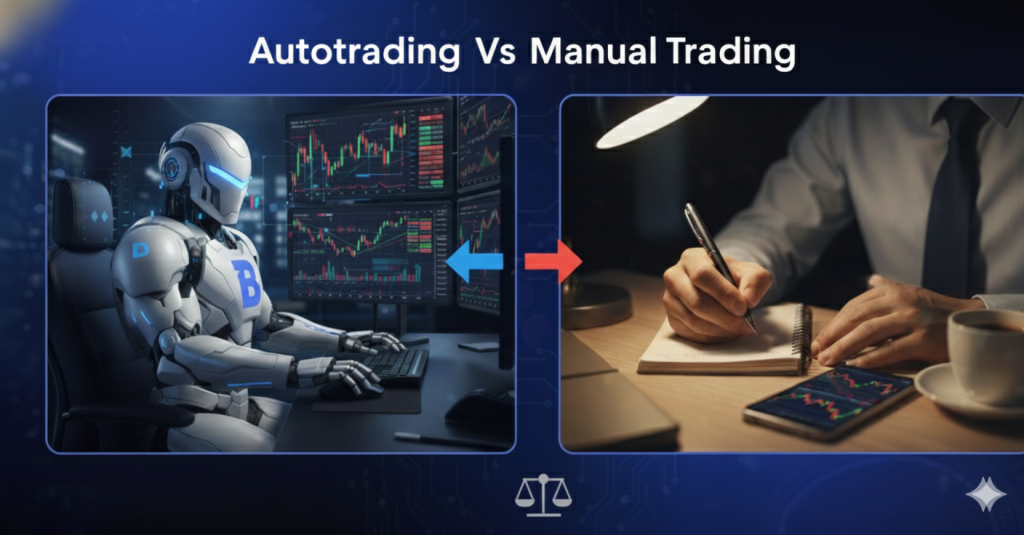For new investors in the cryptocurrency markets, autotrading vs manual trading choice normally appears overwhelming. Autotrading typically dominates manual trading by cutting out emotions, saving time, and implementing strategies 24/7. However, knowing about autotrading vs manual trading and understanding the difference of both strategies is necessary before making the choice. Let’s learn the key differences to help you make a wise choice.
The Reality of Manual Crypto Trading
Manual trading means you’re the pilot – every decision rests on your shoulders. I remember my first manual trades back in 2017. My hands would literally shake when clicking the “buy” button. Here’s what this approach truly involves:
The Day-to-Day of Manual Trading:
- Spending hours analyzing candlestick charts
- Setting price alerts across multiple devices
- Making split-second decisions during volatile periods
- Dealing with the emotional rollercoaster of wins and losses
The Skills Required:
- Technical Analysis: Understanding support/resistance, indicators like RSI and MACD
- Risk Management: Calculating position sizes and setting stop-losses
- Emotional Control: Avoiding FOMO buys and panic sells
Automated Trading: The Modern Approach
Automated crypto trading uses programmed algorithms to execute trades based on your predefined rules. At BTZO, we’ve seen countless beginners transform their results by implementing simple automated strategies.
How It Works in Practice:
- You set parameters (buy/sell conditions, amounts, risk limits)
- The bot monitors markets 24/7
- Trades execute automatically when conditions are met
- You receive notifications and performance reports
The BTZO Difference:
What makes our automated crypto trading bots stand out is the focus on accessibility:
- Visual strategy builder (no coding needed)
- Pre-configured templates for common approaches
- Real-time adjustments without stopping your bot
Detailed Comparison: Autotrading vs Manual Trading
Let’s break down the key differences with real-world example
The Hidden Challenges of Manual Trading
While manual trading teaches valuable skills, new traders often underestimate these obstacles:
The Time Trap
- Crypto moves fastest when you’re busiest (work hours, family time)
- Most profitable opportunities occur outside normal waking hours
- Continuous monitoring leads to burnout
The Psychology Factor
- 78% of manual traders admit to overtrading after losses
- Confirmation bias leads to ignoring warning signs
- “Revenge trading” after losses compounds problems
The Technical Hurdles
- Chart analysis requires months of practice
- Managing multiple indicators becomes overwhelming
- Platform navigation itself presents a learning curve
Understanding AutoTrading Limitations
- While automation solves many beginner challenges, it’s not perfect:
Potential Drawbacks:
- Requires initial setup time (though BTZO simplifies this)
- Can’t account for unexpected news events
- Over-optimization risk (working in theory but failing live)
The Hybrid Approach: Best of Auto trading vs Manual Trading
Many successful traders eventually combine both methods:
Suggested Allocation for Beginners:
- 70% in automated core strategies
- 20% in manual discretionary trades
- 10% in cash for unexpected opportunities
Sample Hybrid Strategy:
Use BTZO AutoTrader for:
- 24/7 Market Monitoring and Execution
- Implementing Complex Strategies
Manual trade for:
- Special situations (protocol upgrades, mergers)
- Small experimental positions
Why BTZO AutoTrader Works for Beginners
Having tested numerous platforms, here’s what makes our solution stand out:
For Absolute Beginners:
- AI Strategies: Pre-built plans that take 3 minutes to launch
- Plain English Explanations: No technical jargon
- User Friendly Interface: Easy to understand
For Those Transitioning from Manual:
- Custom Strategy Import: Bring your manual approach into automation
- Performance Analytics: Compare auto vs. manual results
- Gradual Complexity: Start simple, add advanced features later
Getting Started: Your Action Plan
Week 1: Education
- Read BTZO blog and related articles
- Do your research on the platform
- Identify 1-2 simple strategies to automate
Week 2-4: Implementation
- Start with small real-money amounts
- Review weekly performance reports
- Join our new trader community for support
Month 2+: Optimization
- Gradually adjust strategy parameters
- Consider adding a second automated approach
- Begin incorporating small manual trades
Final Thoughts: Making the Right Choice
After years in this space, if a newbie asked what is better on autotrading vs manual trading, my honest advice to new traders is this: Start with automation to build confidence and consistency, then gradually incorporate manual techniques as your knowledge grows. The BTZO AutoTrader platform is specifically designed to support this journey, helping you avoid common pitfalls while developing your trading skills.
Remember, the “best” approach depends on your:
- Available time
- Emotional temperament
- Learning style
- Financial goals
Begin with BTZO AutoTrader today and take your first step toward smarter, more sustainable trading.
FAQs
With proper safeguards, yes. BTZO’s automated systems use 6 digit OTPs, 2FA authenticator codes, withdrawal confirmations to protect your funds.
Our preset strategies require zero technical skills. As you progress, you’ll naturally learn more about how the strategies work.
All BTZO strategies include mandatory stop-loss protection and volatility pauses to limit downside risk during extreme events.
Absolutely. Many traders use automation while learning, then gradually incorporate manual techniques.
Strategies can start with as little as 5 USDT, making automation accessible.
Yes—when properly configured with stop-losses. BTZO bots can outperform emotional manual traders during volatility.




































